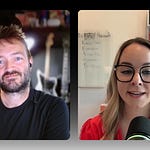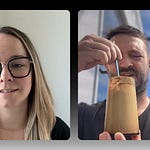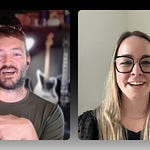We’re together in Chattanooga today at a fundraising event so we did our Seth Said What? episode in a back room between handshakes. Short episode. Big idea. Be the brand that listens.
TL;DR: Refunds don’t create loyalty. Being heard does. Design your service like a product: name-to-name, fast loops, and visible learning. Special guest, Strider Hall, makes an appearance!
The spark
Seth wrote today about why big-company customer service so often feels pointless: it’s optimized for minimizing time and issuing refunds, not for responsibility or learning. In his words, “Big companies can’t take responsibility, only humans can.” We want to be heard, understood, and responded to—and we want to see the organization get better because of it.
Our take (from a green room in Chattanooga)
McDonald’s vs. Chick-fil-A (real world): Price promos and rebrands can’t cover a broken interaction. Two kiosks down, nobody at the counter, and silence > any “value meal.” Meanwhile, Chick-fil-A operationalized being seen—from drive-thru choreography to human checkpoints. The experience is the brand.
Granola (software we love): We wrote support to move recordings from a work account. A human replied by name, used our name, apologized for the delay, and closed the loop: “Done.” Five lines of humanity > a 500-word macro. That tiny moment built trust and advocacy on the spot.
The playbook: Make “being heard” shippable
Put a name on it
Every customer hears from a person, not a queue. First line of every reply: “Hey [Name], I’m [Your Name]—I’ve got this.”Answer the real question
Identify the job to be done in the first reply (“It sounds like you want X to Y”). Then say exactly what will happen next and when. (If you can do it now, do it now.)Close the loop in public
When you fix a recurring issue, publish a 2-sentence “What we learned / What we changed.” You’ve now turned a complaint into product R&D (and free marketing). Seth’s point: it’s cheaper than refunds and it makes you better.Instrument for listening, not deflection
Kill dark patterns (endless IVRs, dead kiosks, “no-reply” emails). Add easy paths to a human and track “felt heard” as a core KPI.Give scripts that sound like people
Replace “Per our policy…” with “Here’s what I can do right now…” Policy is the safety net; voice is the bridge.
Swipe these (steal our lines)
First reply:
“Hey [Name], I’m [Agent]. I read your note twice to make sure I got it. You want [Outcome]. I can do [Action] right now, and I’ll confirm by [Time]. If we miss that, I’ll tell you why and what we’re changing.”When it’s your fault:
“You’re right—we missed here. I fixed [Thing] and added [Safeguard] so it doesn’t repeat. Thanks for helping us get better.”When you must say no:
“I can’t do [Request] today. Here are two options I can do, plus why: [Option A] / [Option B]. If either works, I’ll set it up.”
Try this this week
Audit one journey (ordering → pickup, or signup → first value). Count the “human checkpoints” vs. dead ends. Ship one added checkpoint.
Rewrite one macro to the “name-to-name” style above, then measure reply rate + resolution time for a week.
Publish one “We learned / We changed” note after your next fix.
Why this matters (beyond Customer Success)
Because service is story. If people like us do things like this, then our people build companies where a real person takes responsibility. That’s culture work, not just customer support. (If you’re racing to the bottom on price, this is your way out.)
Your turn
Who’s actually doing customer service well right now—online or in real life? Drop your favorites in the comments so we can feature them (and learn from them) in a follow-up.















